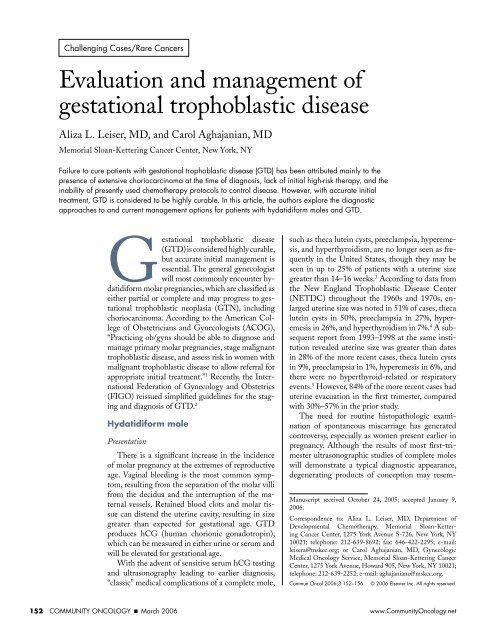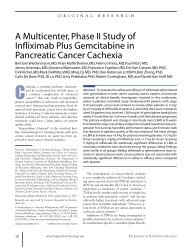Evaluation and management of gestational trophoblastic disease
Evaluation and management of gestational trophoblastic disease
Evaluation and management of gestational trophoblastic disease
Create successful ePaper yourself
Turn your PDF publications into a flip-book with our unique Google optimized e-Paper software.
Challenging Cases/Rare Cancers<br />
<strong>Evaluation</strong> <strong>and</strong> <strong>management</strong> <strong>of</strong><br />
<strong>gestational</strong> <strong>trophoblastic</strong> <strong>disease</strong><br />
Aliza L. Leiser, MD, <strong>and</strong> Carol Aghajanian, MD<br />
Memorial Sloan-Kettering Cancer Center, New York, NY<br />
Failure to cure patients with <strong>gestational</strong> <strong>trophoblastic</strong> <strong>disease</strong> (GTD) has been attributed mainly to the<br />
presence <strong>of</strong> extensive choriocarcinoma at the time <strong>of</strong> diagnosis, lack <strong>of</strong> initial high-risk therapy, <strong>and</strong> the<br />
inability <strong>of</strong> presently used chemotherapy protocols to control <strong>disease</strong>. However, with accurate initial<br />
treatment, GTD is considered to be highly curable. In this article, the authors explore the diagnostic<br />
approaches to <strong>and</strong> current <strong>management</strong> options for patients with hydatidiform moles <strong>and</strong> GTD.<br />
G<br />
estational <strong>trophoblastic</strong> <strong>disease</strong><br />
(GTD) is considered highly curable,<br />
but accurate initial <strong>management</strong> is<br />
essential. The general gynecologist<br />
will most commonly encounter hydatidiform<br />
molar pregnancies, which are classified as<br />
either partial or complete <strong>and</strong> may progress to <strong>gestational</strong><br />
<strong>trophoblastic</strong> neoplasia (GTN), including<br />
choriocarcinoma. According to the American College<br />
<strong>of</strong> Obstetricians <strong>and</strong> Gynecologists (ACOG),<br />
“Practicing ob/gyns should be able to diagnose <strong>and</strong><br />
manage primary molar pregnancies, stage malignant<br />
<strong>trophoblastic</strong> <strong>disease</strong>, <strong>and</strong> assess risk in women with<br />
malignant <strong>trophoblastic</strong> <strong>disease</strong> to allow referral for<br />
appropriate initial treatment.” 1 Recently, the International<br />
Federation <strong>of</strong> Gynecology <strong>and</strong> Obstetrics<br />
(FIGO) reissued simplified guidelines for the staging<br />
<strong>and</strong> diagnosis <strong>of</strong> GTD. 2<br />
Hydatidiform mole<br />
Presentation<br />
There is a significant increase in the incidence<br />
<strong>of</strong> molar pregnancy at the extremes <strong>of</strong> reproductive<br />
age. Vaginal bleeding is the most common symptom,<br />
resulting from the separation <strong>of</strong> the molar villi<br />
from the decidua <strong>and</strong> the interruption <strong>of</strong> the maternal<br />
vessels. Retained blood clots <strong>and</strong> molar tissue<br />
can distend the uterine cavity, resulting in size<br />
greater than expected for <strong>gestational</strong> age. GTD<br />
produces hCG (human chorionic gonadotropin),<br />
which can be measured in either urine or serum <strong>and</strong><br />
will be elevated for <strong>gestational</strong> age.<br />
With the advent <strong>of</strong> sensitive serum hCG testing<br />
<strong>and</strong> ultrasonography leading to earlier diagnosis,<br />
“classic” medical complications <strong>of</strong> a complete mole,<br />
such as theca lutein cysts, preeclampsia, hyperemesis,<br />
<strong>and</strong> hyperthyroidism, are no longer seen as frequently<br />
in the United States, though they may be<br />
seen in up to 25% <strong>of</strong> patients with a uterine size<br />
greater than 14–16 weeks. 3 According to data from<br />
the New Engl<strong>and</strong> Trophoblastic Disease Center<br />
(NETDC) throughout the 1960s <strong>and</strong> 1970s, enlarged<br />
uterine size was noted in 51% <strong>of</strong> cases, theca<br />
lutein cysts in 50%, preeclampsia in 27%, hyperemesis<br />
in 26%, <strong>and</strong> hyperthyroidism in 7%. 4 A subsequent<br />
report from 1993–1998 at the same institution<br />
revealed uterine size was greater than dates<br />
in 28% <strong>of</strong> the more recent cases, theca lutein cysts<br />
in 9%, preeclampsia in 1%, hyperemesis in 6%, <strong>and</strong><br />
there were no hyperthyroid-related or respiratory<br />
events. 5 However, 84% <strong>of</strong> the more recent cases had<br />
uterine evacuation in the first trimester, compared<br />
with 30%–57% in the prior study.<br />
The need for routine histopathologic examination<br />
<strong>of</strong> spontaneous miscarriage has generated<br />
controversy, especially as women present earlier in<br />
pregnancy. Although the results <strong>of</strong> most first-trimester<br />
ultrasonographic studies <strong>of</strong> complete moles<br />
will demonstrate a typical diagnostic appearance,<br />
degenerating products <strong>of</strong> conception may resem-<br />
Manuscript received October 24, 2005; accepted January 9,<br />
2006.<br />
Correspondence to: Aliza L. Leiser, MD, Department <strong>of</strong><br />
Developmental Chemotherapy, Memorial Sloan-Kettering<br />
Cancer Center, 1275 York Avenue S-726, New York, NY<br />
10021; telephone: 212-639-8692; fax: 646-422-2295; e-mail:<br />
leisera@mskcc.org; or Carol Aghajanian, MD, Gynecologic<br />
Medical Oncology Service, Memorial Sloan-Kettering Cancer<br />
Center, 1275 York Avenue, Howard 905, New York, NY 10021;<br />
telephone: 212-639-2252; e-mail: aghajanianc@mskcc.org.<br />
Commun Oncol 2006;3:152–156<br />
© 2006 Elsevier Inc. All rights reserved.<br />
152 COMMUNITY ONCOLOGY ■ March 2006 www.CommunityOncology.net
<strong>Evaluation</strong> <strong>and</strong> <strong>management</strong> <strong>of</strong> GTD<br />
CHALLENGING CASES/RARE CANCERS<br />
ble early molar <strong>disease</strong>. 6,7 This is especially<br />
true for partial molar pregnancies,<br />
for which ultrasonographic<br />
characteristics may be difficult to<br />
identify prior to the second trimester;<br />
they are <strong>of</strong>ten diagnosed as missed<br />
abortions. There is no evidence that<br />
routine use <strong>of</strong> pathologic or early ultrasonographic<br />
studies is cost-effective<br />
or will decrease the incidence <strong>of</strong><br />
GTN, but some investigators recommend<br />
submitting all tissue obtained<br />
for histopathologic evaluation <strong>and</strong>/or<br />
follow-up with hCG testing. 8 Similar<br />
concerns have been expressed for<br />
women undergoing early elective termination<br />
<strong>of</strong> pregnancy.<br />
<strong>Evaluation</strong> <strong>and</strong> <strong>management</strong><br />
Initial evaluation for molar <strong>disease</strong><br />
should include a work-up for anemia,<br />
preeclampsia, electrolyte imbalance,<br />
<strong>and</strong> hyperthyroidism as well as a<br />
baseline chest x-ray. Pulmonary complications<br />
have been noted in patients<br />
with a <strong>gestational</strong> size greater than 16<br />
weeks <strong>and</strong> are associated with preeclampsia,<br />
fluid overload, anemia, hyperthyroidism,<br />
or emboli at the time<br />
<strong>of</strong> evacuation.<br />
Suction curettage is st<strong>and</strong>ard<br />
treatment, unless fetal structures (ie, a<br />
partial mole) preclude the use <strong>of</strong> this<br />
method. 9 Medical methods are associated<br />
with a higher rate <strong>of</strong> chemotherapy<br />
<strong>and</strong> should not be used. 9 If<br />
the patient does not wish future childbearing,<br />
a hysterectomy decreases the<br />
risk <strong>of</strong> malignant sequelae to 3%–5%<br />
but does not eliminate the need for<br />
close follow-up. A laparotomy set <strong>and</strong><br />
facilities for hemodynamic monitoring<br />
should be available during evacuation<br />
<strong>of</strong> the mole with significant uterine<br />
enlargement. Oxytocin should be<br />
initiated in the operating room before<br />
the procedure is performed, <strong>and</strong> blood<br />
products should be readily available.<br />
Hypertension <strong>and</strong> hyperthyroidism<br />
usually resolve acutely after evacuation,<br />
although it may take ovarian<br />
cysts from hCG stimulation several<br />
months to resolve.<br />
Follow-up<br />
Approximately 20% <strong>of</strong> complete<br />
molar pregnancies <strong>and</strong> 5% <strong>of</strong> partial<br />
molar pregnancies have malignant<br />
sequelae requiring chemotherapy<br />
after uterine evacuation. 10 Clinical<br />
features associated with such an increased<br />
risk include pre-evacuation<br />
hCG levels, uterine size, theca lutein<br />
cysts, associated medical factors, maternal<br />
age > 40 years, <strong>and</strong> previous<br />
molar pregnancy.<br />
After molar evacuation, patients<br />
should be followed with serial serum<br />
hCG values <strong>and</strong> are considered to<br />
have achieved remission when hCG<br />
levels decline to undetectable levels<br />
for 6 months. 11 The NETDC has<br />
suggested that postevacuation monitoring<br />
for women with uncomplicated<br />
molar pregnancy may be shortened<br />
without compromising risk, as<br />
no patient at this center recurred after<br />
achieving two consecutive undetectable<br />
hCG levels. 12 Patients also<br />
should use reliable contraception so<br />
as not to obscure the diagnosis <strong>of</strong> persistent<br />
or recurrent <strong>disease</strong>. Use <strong>of</strong><br />
oral contraceptives neither increases<br />
the risk <strong>of</strong> GTN nor causes a delay<br />
in achieving normal hCG values. 13<br />
Pelvic examination should document<br />
uterine involution <strong>and</strong> may identify<br />
early vaginal metastasis.<br />
Gestational <strong>trophoblastic</strong><br />
neoplasm<br />
Diagnosis<br />
After a complete molar pregnancy,<br />
the majority <strong>of</strong> cases <strong>of</strong> GTN will<br />
consist <strong>of</strong> nonmetastatic persistent or<br />
invasive moles. The minority <strong>of</strong> cases<br />
will involve metastatic <strong>disease</strong>, which<br />
may manifest histologically as a choriocarcinoma.<br />
The diagnosis <strong>of</strong> GTN<br />
after molar pregnancy is most commonly<br />
determined by persistently rising<br />
or plateauing hCG levels after<br />
evacuation; alternatively, GTN can be<br />
diagnosed if histologic results from the<br />
uterine evacuation show invasive molar<br />
proliferation, choriocarcinoma, or <strong>trophoblastic</strong><br />
tumor <strong>of</strong> the placental site.<br />
New intrauterine pregnancy should be<br />
ruled out on the basis <strong>of</strong> hCG levels<br />
<strong>and</strong> ultrasonographic findings.<br />
The FIGO Council 2000 criteria<br />
for the diagnosis <strong>of</strong> posthydatidiform<br />
mole GTN follow:<br />
■<br />
■<br />
■<br />
■<br />
A rise in hCG level <strong>of</strong> 10% or<br />
higher <strong>of</strong> three values recorded over<br />
2 weeks (days 1, 7, <strong>and</strong> 14)<br />
A plateau in hCG level ( ± 10%) <strong>of</strong><br />
four values recorded over 3 weeks<br />
(days 1, 7, 14, <strong>and</strong> 21)<br />
The persistence <strong>of</strong> a detectable hCG<br />
level at 6 months or more after<br />
evacuation <strong>of</strong> the mole<br />
A histologic diagnosis <strong>of</strong><br />
choriocarcinoma<br />
Less commonly, choriocarcinoma<br />
will develop after a nonmolar gestation,<br />
including normal pregnancy,<br />
abortion, or ectopic pregnancy. Cases<br />
not following a known prior molar<br />
pregnancy may present many years after<br />
an antecedent pregnancy, <strong>and</strong> diagnosis<br />
can initially be baffling. Having<br />
a high index <strong>of</strong> suspicion may avoid<br />
an unnecessary thoracotomy or craniotomy<br />
for diagnostic purposes when a<br />
simple hCG level can be diagnostic.<br />
Any woman <strong>of</strong> reproductive age with<br />
brain metastasis or cerebral hemorrhage<br />
<strong>of</strong> unexplained etiology should<br />
be screened for GTN with an hCG<br />
level. For the patient with abnormal<br />
bleeding for more than 6 weeks after<br />
pregnancy, dilation <strong>and</strong> curettage may<br />
be helpful, although <strong>disease</strong> is sometimes<br />
deep in the myometrium <strong>and</strong><br />
unobtainable by curettage. Additionally,<br />
<strong>disease</strong> may sometimes be confined<br />
to metastatic implants.<br />
False-positive or phantom<br />
hCG level results<br />
In 2001, the Society for Gynecologic<br />
Oncologists issued a warning<br />
regarding phantom hCG results.<br />
Laboratory assays for hCG levels may<br />
yield false-positive results, which have<br />
been reported to be as high as 800<br />
mIU/mL or possibly higher. These<br />
Volume 3/Number 3<br />
March 2006 ■ COMMUNITY ONCOLOGY 153
CHALLENGING CASES/RARE CANCERS<br />
Leiser/Aghajanian<br />
false-positive results may be caused<br />
by antimouse antibodies, heterophile<br />
antibodies, <strong>and</strong> a nonspecific protein<br />
interface. Furthermore, false-positive<br />
results have been reported with many<br />
different assay kits (platforms) from<br />
numerous manufacturers. 14<br />
Since the <strong>management</strong> <strong>of</strong> GTD<br />
is <strong>of</strong>ten guided by the hCG level, it<br />
is important to consider the possibility<br />
<strong>of</strong> a false-positive result, especially<br />
in discordant clinical situations.<br />
The presumptive diagnosis <strong>of</strong> either<br />
ectopic pregnancy or GTN has been<br />
the basis <strong>of</strong> unnecessary treatment. A<br />
prime consideration is to obtain a urinary<br />
hCG level, since the substances<br />
do not appear to be excreted in their<br />
interfering form in the urine.<br />
Classification<br />
The work-up <strong>of</strong> GTN must establish<br />
whether the <strong>disease</strong> is locally invasive<br />
or metastatic <strong>and</strong> whether the<br />
risk <strong>of</strong> therapeutic failure is high or<br />
low. The pattern <strong>of</strong> metastatic spread<br />
is hematogenous, <strong>and</strong> metastasis to the<br />
lungs is most common initially, followed<br />
by systemic dissemination, <strong>of</strong>ten<br />
to the brain <strong>and</strong> liver. At this point, the<br />
work-up to identify metastatic <strong>disease</strong><br />
should include the following:<br />
■ Complete blood cell count (CBC),<br />
liver function tests, examination for<br />
clotting deficiency<br />
■ Neurologic <strong>and</strong> funduscopic examinations<br />
■ Examination <strong>of</strong> the vaginal fornices<br />
<strong>and</strong> suburethral areas<br />
■ Chest x-ray, brain MRI or CT, abdominal<br />
CT, <strong>and</strong> liver MRI or CT.<br />
Several classification systems for<br />
GTN exist, all <strong>of</strong> which identify patients<br />
at risk for therapeutic failure. The clinical<br />
classification system has been traditionally<br />
used in the United States <strong>and</strong><br />
separates metastatic GTN according<br />
to prognosis (Table 1). 15 However, in<br />
March 2002, the FIGO Council published<br />
the revised classification system<br />
for GTN combining the previous anatomic<br />
FIGO staging with the modified<br />
World Health Organization (WHO)<br />
TABLE 1<br />
Traditional classification system for <strong>gestational</strong> <strong>trophoblastic</strong> <strong>disease</strong><br />
Stage<br />
Stage I<br />
Stage II<br />
Description<br />
Nonmetastatic <strong>gestational</strong> <strong>trophoblastic</strong> <strong>disease</strong><br />
Metastatic <strong>gestational</strong> <strong>trophoblastic</strong> <strong>disease</strong><br />
A. Good prognosis<br />
1. Urinary hCG level < 100,000 IU/24 h or serum hCG level<br />
< 40,000 IU/L<br />
2. Symptoms present for < 4 months<br />
3. No brain or liver metastases<br />
4. No prior chemotherapy<br />
5. Pregnancy is not term delivery (ie, mole, ectopic, or spontaneous<br />
abortion)<br />
B. Poor prognosis<br />
1. Urinary hCG level > 100,000 IU/24 h or serum hCG level<br />
> 40,000 IU/L serum<br />
2. Symptoms present for > 4 months<br />
3. Brain or liver metastases<br />
4. Prior chemotherapeutic failure<br />
5. Antecedent term pregnancy<br />
hCG = human chorionic gonadotropin<br />
TABLE 2<br />
Revised FIGO classification system for <strong>gestational</strong> <strong>trophoblastic</strong> neoplasia<br />
Stage<br />
Stage I<br />
Stage II<br />
Stage III<br />
Stage IV<br />
Disease confined to the uterus<br />
Description<br />
GTN extends outside the uterus but is limited to the genital structures<br />
(adnexa, vagina, broad ligament)<br />
GTN extends to the lungs with or without genital tract involvement<br />
All other metastatic sites<br />
FIGO risk factor score<br />
Variable 0 1 2 4<br />
Age (years) – 40 > 40 –<br />
Antecedent term Hydatidiform Abortion Term –<br />
pregnancy<br />
mole<br />
Interval (months) from < 4 4–6 7–12 > 12<br />
index pregnancy<br />
Pretreatment hCG level < 10 3 10 3 –10 4 > 10 4 –10 5 > 10 5<br />
(mIU/mL)<br />
Largest tumor size, – 3–4 cm 5 cm –<br />
including uterus<br />
Site <strong>of</strong> metastases – Spleen/kidneys GI tract Brain/liver<br />
Number <strong>of</strong> metastases 0 1–4 5–8 > 8<br />
identified<br />
Previous failed – – Single Two or<br />
chemotherapy drug more drugs<br />
FIGO = International Federation <strong>of</strong> Gynecology <strong>and</strong> Obstetrics; GTN = <strong>gestational</strong> <strong>trophoblastic</strong> neoplasia;<br />
hCG = human chorionic gonadotropin; GI = gastrointestinal<br />
risk factor scoring system (Table 2). 2<br />
Management<br />
Initial treatment <strong>of</strong> low-risk GTD<br />
consists <strong>of</strong> single-agent chemotherapy,<br />
usually methotrexate with or without<br />
folic acid rescue or dactinomycin<br />
(Cosmegen), <strong>and</strong> is continued for 1<br />
cycle after the first normal hCG value.<br />
16 If the tumor is resistant to ini-<br />
154 COMMUNITY ONCOLOGY ■ March 2006 www.CommunityOncology.net
<strong>Evaluation</strong> <strong>and</strong> <strong>management</strong> <strong>of</strong> GTD<br />
CHALLENGING CASES/RARE CANCERS<br />
tial single-agent therapy, <strong>and</strong> the patient<br />
is still at low risk, the alternative<br />
single agent is utilized. If alternative<br />
single-agent therapy fails, the patient<br />
is treated with multiagent regimens.<br />
Although 10%–15% <strong>of</strong> patients with<br />
low-risk <strong>disease</strong> will require multiagent<br />
chemotherapy with or without<br />
surgery to achieve remission, nearly<br />
all patients can be salvaged.<br />
The combination chemotherapy<br />
EMA-CO (etoposide, methotrexate,<br />
dactinomycin, cyclophosphamide,<br />
vincristine [Oncovin]) has widely<br />
become accepted as the treatment <strong>of</strong><br />
high-risk <strong>disease</strong>, 17 although there is<br />
a dearth <strong>of</strong> r<strong>and</strong>omized studies in patients<br />
with this <strong>disease</strong>. EMA-CO<br />
may improve the primary response<br />
rate <strong>and</strong> lower the acute toxicity rate,<br />
compared with MAC (methotrexate,<br />
dactinomycin, <strong>and</strong> cyclophosphamide),<br />
especially among patients<br />
at high risk, but theoretically may increase<br />
the risk <strong>of</strong> leukemia. 18 Twenty-five<br />
percent <strong>of</strong> patients with highrisk<br />
<strong>disease</strong> will have an incomplete<br />
response to or relapse from a methotrexate-containing<br />
regimen such as<br />
EMA-CO. These patients should be<br />
treated with salvage chemotherapy<br />
regimens employing platinum, <strong>of</strong>ten<br />
in conjunction with surgical resection<br />
<strong>of</strong> sites <strong>of</strong> persistent tumor in the<br />
uterus or lungs. 19 Many patients with<br />
resistant tumors are initially treated<br />
ineffectively; therefore, the importance<br />
<strong>of</strong> appropriate referral <strong>of</strong> patients<br />
with high-risk GTD to clinicians<br />
who have experience with this<br />
relatively rare <strong>disease</strong> cannot be overemphasized.<br />
The use <strong>of</strong> a second evacuation is<br />
limited in the United States to patients<br />
with persistent uterine bleeding,<br />
although the Sheffield Trophoblastic<br />
Disease Center in the United<br />
Kingdom has reported that second<br />
curettage eliminated the need for<br />
chemotherapy in 60% <strong>of</strong> patients<br />
with persistent GTD. 20 Second evacuation<br />
is most useful in patients with<br />
retained partial molar tissue. Hysterectomy<br />
will shorten the duration <strong>and</strong><br />
lower the dosage <strong>of</strong> chemotherapy administered<br />
<strong>and</strong> may be considered for<br />
patients who do not desire fertility. 21<br />
Disease refractory to chemotherapy<br />
<strong>and</strong> confined to the uterus may also<br />
be treated with hysterectomy.<br />
Subsequent pregnancy<br />
Most patients can expect a normal<br />
reproductive outcome for pregnancies<br />
occurring at least 6 months after the<br />
completion <strong>of</strong> treatment, although for<br />
unclear reasons, several series have reported<br />
a higher stillbirth rate for such<br />
patients. 22–25 No differences in pregnancy<br />
outcomes have been noted between<br />
those treated with combination<br />
chemotherapy <strong>and</strong> those treated<br />
For more information<br />
Visit the comprehensive <strong>and</strong> authoritative<br />
Web site <strong>of</strong> the International Society<br />
for the Study <strong>of</strong> Trophoblastic Diseases<br />
(www.isstd.org). The site includes<br />
an online reference book written by<br />
world renowned experts <strong>and</strong> information<br />
for patients.<br />
with single-agent chemotherapy. No<br />
increase in congenital malformations<br />
has been reported in those who have<br />
received chemotherapy. Infertility<br />
rates after chemotherapy for GTN<br />
appear to be no higher than those for<br />
the general population.<br />
As the risk <strong>of</strong> recurrence is about<br />
1% with one molar pregnancy <strong>and</strong><br />
15%–28% with two molar pregnancies,<br />
late first-trimester ultrasonography<br />
should be performed with all<br />
subsequent pregnancies. 23 Six weeks<br />
after delivery, an hCG level should<br />
be obtained to exclude occult choriocarcinoma.<br />
Although all products<br />
<strong>of</strong> conception should be examined<br />
pathologically after a subsequent<br />
spontaneous or therapeutic abortion,<br />
the utility <strong>of</strong> routine placental examination<br />
after a subsequent normal<br />
pregnancy is questionable. Patients<br />
should be counseled that pregnancy<br />
prior to the completion <strong>of</strong> follow-up<br />
is likely safe, but a relapse would be<br />
more difficult to detect. Any vaginal<br />
bleeding or systemic symptoms<br />
should be promptly evaluated.<br />
As recurrent molar pregnancies<br />
have been documented with a change<br />
<strong>of</strong> partner, <strong>and</strong> even with donor insemination,<br />
a primary oocyte is probable<br />
in such cases. 24 Patients with repetitive<br />
molar pregnancies may benefit<br />
from assisted reproductive techniques,<br />
such as intracytoplasmic sperm injection<br />
combined with preimplantation<br />
genetics, to confirm the biparental origin<br />
or alternatively the donor ovum 23 ;<br />
these patients also have a high risk <strong>of</strong><br />
developing GTN with each subsequent<br />
episode <strong>of</strong> molar <strong>disease</strong>.<br />
Conclusion<br />
The past 40 years have seen significant<br />
advances in the treatment<br />
<strong>of</strong> GTD. Regional treatment centers<br />
have been created to provide excellent<br />
<strong>management</strong> <strong>and</strong> follow-up care; new<br />
therapies <strong>and</strong> clinical classifications<br />
related to therapy have also been developed.<br />
Failure to cure patients with<br />
GTD is attributable mainly to the<br />
presence <strong>of</strong> extensive choriocarcinoma<br />
at the time <strong>of</strong> diagnosis, lack <strong>of</strong><br />
initial high-risk therapy, <strong>and</strong> the inability<br />
<strong>of</strong> presently used chemotherapy<br />
protocols to control <strong>disease</strong>.<br />
References<br />
1. Soper JT, Mutch DG, Schink JC; American<br />
College <strong>of</strong> Obstetricians <strong>and</strong> Gynecologists.<br />
Diagnosis <strong>and</strong> treatment <strong>of</strong> <strong>gestational</strong><br />
<strong>trophoblastic</strong> <strong>disease</strong>: ACOG Practice Bulletin<br />
No. 53. Gynecol Oncol 2004;93: 575–585.<br />
2. FIGO Oncology Committee Report.<br />
FIGO staging for <strong>gestational</strong> <strong>trophoblastic</strong><br />
neoplasia 2000. Int J Gynaecol Obstet<br />
2002;77:285–287.<br />
3. Schlaerth JB, Morrow CP, Montz FJ,<br />
d’Ablaing G. Initial <strong>management</strong> <strong>of</strong> hydatidiform<br />
mole. Am J Obstet Gynecol 1988;158(6<br />
pt 1):1299–1306.<br />
4. DuBeshter B, Berkowitz RS, Goldstein<br />
DP, Cramer DW, Bernstein MR. Metastatic<br />
<strong>gestational</strong> <strong>trophoblastic</strong> <strong>disease</strong>: experience at<br />
the New Engl<strong>and</strong> Trophoblastic Disease Center,<br />
1965 to 1985. Obstet Gynecol 1987;69(3<br />
pt 1):390–395.<br />
5. Soto-Wright V, Bernstein M, Goldstein<br />
DP, Berkowitz RS. The changing clinical pre-<br />
Volume 3/Number 3<br />
March 2006 ■ COMMUNITY ONCOLOGY 155
CHALLENGING CASES/RARE CANCERS<br />
Leiser/Aghajanian<br />
sentation <strong>of</strong> complete molar pregnancy. Obstet<br />
Gynecol 1995;86:775–779.<br />
6. Johns J, Greenwold N, Buckley S, Jauniaux<br />
E. A prospective study <strong>of</strong> ultrasound screening for<br />
molar pregnancies in missed miscarriages. Ultrasound<br />
Obstet Gynecol 2005;25:493–497.<br />
7. Benson CB, Genest DR, Bernstein MR,<br />
Soto-Wright V, Goldstein DP, Berkowitz RS.<br />
Sonographic appearance <strong>of</strong> first trimester complete<br />
hydatidiform moles. Ultrasound Obstet<br />
Gynecol 2000;16:188–191.<br />
8. Sebire NJ. The diagnosis <strong>of</strong> <strong>gestational</strong><br />
<strong>trophoblastic</strong> <strong>disease</strong> in early pregnancy:<br />
implications for screening, counseling <strong>and</strong><br />
<strong>management</strong>. Ultrasound Obstet Gynecol<br />
2005;25:421–424.<br />
9. Tidy JA, Gillespie AM, Bright N, Radstone<br />
CR, Coleman RE, Hancock BW. Gestational<br />
<strong>trophoblastic</strong> <strong>disease</strong>: a study <strong>of</strong> mode <strong>of</strong><br />
evacuation <strong>and</strong> subsequent need for treatment<br />
with chemotherapy. Gynecol Oncol 2000;78 (3<br />
pt 1):309–312.<br />
10. Soper JT, Lewis Jr JL, Hammond<br />
CB. Gestational <strong>trophoblastic</strong> <strong>disease</strong>. In:<br />
Hoskins WJ, Perez CA, Young RC, eds. Principles<br />
<strong>and</strong> Practice <strong>of</strong> Gynecologic Oncology,<br />
2nd ed. Philadelphia, Pa: Lippincott-Raven;<br />
1997:1039–1077.<br />
11. Berkowitz RS, Goldstein DP, Bernstein<br />
MR. Management <strong>of</strong> nonmetastatic <strong>trophoblastic</strong><br />
tumors. J Reprod Med 1981;26:219–222.<br />
12. Feltmate CM, Batorfi J, Fulop V, Goldstein<br />
DP, Doszpod J, Berkowitz RS. Human<br />
chorionic gonadotropin follow-up in patients<br />
with molar pregnancy: a time for reevaluation.<br />
Obstet Gynecol 2003;101:732–736.<br />
13. Parazzini F, Cipriani S, Mangili G,<br />
et al. Oral contraceptives <strong>and</strong> risk <strong>of</strong> <strong>gestational</strong><br />
<strong>trophoblastic</strong> <strong>disease</strong>. Contraception<br />
2002;65:425–427.<br />
14. Cole LA, Sutton JM. Selecting an appropriate<br />
hCG test for managing <strong>gestational</strong><br />
<strong>trophoblastic</strong> <strong>disease</strong> <strong>and</strong> cancer. J Reprod Med<br />
2004;49:545–553.<br />
15. Hammond CB, Borchert LG, Tyrey<br />
L, Creasman WT, Parker RT. Treatment<br />
<strong>of</strong> metastatic <strong>trophoblastic</strong> <strong>disease</strong>: good<br />
<strong>and</strong> poor prognosis. Am J Obstet Gynecol<br />
1973;115:451–457.<br />
16. Osborne R, Gerulath A. What is the<br />
best regimen for low-risk <strong>gestational</strong> <strong>trophoblastic</strong><br />
neoplasia? a review. J Reprod Med<br />
2004;49:602–616.<br />
17. Newl<strong>and</strong>s ES, Bagshawe KD, Begent<br />
RH, Rustin GJ, Holden L. Results with the<br />
EMA/CO (etoposide, methotrexate, actinomycin<br />
D, cyclophosphamide, vincristine) regimen<br />
in high risk <strong>gestational</strong> <strong>trophoblastic</strong> tumours,<br />
1979 to 1989. Br J Obstet Gynaecol<br />
1991;98:550–557.<br />
18. Soto-Wright V, Goldstein DP, Bernstein<br />
MR, Berkowitz RS. The <strong>management</strong> <strong>of</strong><br />
<strong>gestational</strong> <strong>trophoblastic</strong> tumors with etoposide,<br />
methotrexate, <strong>and</strong> actinomycin D. Gyneco<br />
Oncol 1997;64:156–159.<br />
19. Lurain JR, Nejad B. Secondary chemotherapy<br />
for high-risk <strong>gestational</strong> <strong>trophoblastic</strong><br />
neoplasia. Gynecol Oncol 2005;97:618–623.<br />
20. Pezeshki M, Hancock BW, Silcocks<br />
P, et al. The role <strong>of</strong> repeat uterine evacuation<br />
in the <strong>management</strong> <strong>of</strong> persistent <strong>gestational</strong><br />
<strong>trophoblastic</strong> <strong>disease</strong>. Gynecol Oncol<br />
2004;95:423–429.<br />
21. Soper JT. Role <strong>of</strong> surgery <strong>and</strong> radiation<br />
therapy in the <strong>management</strong> <strong>of</strong> <strong>gestational</strong> <strong>trophoblastic</strong><br />
<strong>disease</strong>. Best Pract Res Clin Obstet<br />
Gynaecol 2003;17:943–957.<br />
22. Matsui H, Iitsuka Y, Suzuka K,<br />
Yamazawa K, Seki K, Sekiya S. Outcome <strong>of</strong><br />
subsequent pregnancy after treatment for persistent<br />
<strong>gestational</strong> <strong>trophoblastic</strong> tumour. Hum<br />
Reprod 2002;17:469–472.<br />
23. Garner EI, Lipson E, Bernstein MR,<br />
Goldstein DP, Berkowitz RS. Subsequent<br />
pregnancy experience in patients with molar<br />
pregnancy <strong>and</strong> <strong>gestational</strong> <strong>trophoblastic</strong> tumor.<br />
J Reprod Med 2002;47:380–386.<br />
24. Tuncer ZS, Bernstein MR, Wang J,<br />
Goldstein DP, Berkowitz RS. Repetitive hydatidiform<br />
mole with different male partners.<br />
Gynecol Oncol 1999;75:224–226.<br />
25. Woolas RP, Bower M, Newl<strong>and</strong>s ES,<br />
Seckl M, Short D, Holden L. Influence <strong>of</strong> chemotherapy<br />
for <strong>gestational</strong> <strong>trophoblastic</strong> <strong>disease</strong><br />
on subsequent pregnancy outcome. Br J Obstet<br />
Gynaecol 1998;105:1032–1035.<br />
ABOUT THE AUTHORS<br />
Affiliations: Dr. Leiser is a research fellow, Department<br />
<strong>of</strong> Developmental Chemotherapy, <strong>and</strong><br />
Dr. Aghajanian is Chief, Gynecologic Medical<br />
Oncology Service, Memorial Sloan-Kettering<br />
Cancer Center, New York, NY.<br />
Conflicts <strong>of</strong> interest: None disclosed.<br />
156 COMMUNITY ONCOLOGY ■ March 2006 www.CommunityOncology.net
















